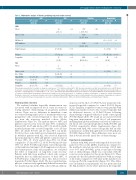Page 185 - 2021_04-Haematologica-web
P. 185
LH suppression and hematopoietic recovery
Table 2. Multivariate analysis of factors predicting long-term count recovery.
ANC
ALC
Platelets 106/L/year P
(95% CI)
Hemoglobin 103 g/dL/year P
(95% CI)
106/L/year (95% CI)
P
106/L/year (95% CI)
P
AML
- - -20 0.02 -557 0.25 --
- - - -
- -
- - - -
PS≤1
Adverserisk
BM blast %
FLT3 inhibitor
Triplet therapy
Relapse Leuprolide
- - -1391 0.006 - - (-2,375, -408)
(-37, -3) (-1,505, 390)
- - -1641 0.001 - - (-2,633, -650)
0.1 (-0.1, 0.3) 0.4
20(8,32) 0.001 - - 5(-9,18) 0.5
-17(-32,-2) 16
(5, 26)
0.02 - 0.003 1412
(433, 2,390)
-
- -
-
0.005
-35(-48,-23) <0.001 14 0.02
(2, 26)
ALL
PS≤1 Adverserisk
- - 2 0.7 (-6, 9)
- - -
- 9(-5,23) 0.2 - - -
- - - -
- - 4(-28,36) 0.8 -68 (-97, -40) <0.001 7 (-6, 19) 0.3
Bvs.TALL
HyperCVAD
Transplant
Relapse 32(4,61) 0.02 - - Leuprolide 28 (0.1, 56) 0.049 0.2 (-11, 12) 1
31 (8, 55) 0.01
-
- - -
-
- 2 (-8, 12) 0.7
Values shown represent effect of variable on change in count per year (95% Confidence Interval [CI]). ANC: absolute neutrophil count; ALC: absolute lymphocyte count; PS: Eastern Cooperative Oncology Group performance status,assessed as PS ≤1 vs. PS≥2;Adverse risk in AML according to the European LeukemiaNet risk stratification,adverse risk in ALL cor- responds to complex karyotype (≥ 5 abnormalities) t(9;22),t(4;11),and low hypodiploidy/near-triploidy,assessed as adverse vs. non-adverse;BM blasts:bone marrow blasts,assessed a continuous variable; Triplet chemotherapy: idarubicin and cytarabine plus a nucleoside analog (i.e., cladribine, clofarabine, or fludarabine), compared to doublet chemotherapy. Transplant corresponds to an allogeneic hematopoietic stem cell transplant; HyperCVAD: hyperfractionated cyclophosphamide, vincristine, adriamycin, dexamethasone, compared to all other treatments. Relapse and transplant were assessed as time-dependent variables. AML: acute myeloid leukemia; ALL: acute lymphoblastic leukemia.
Hematopoietic recovery
We evaluated whether leuprolide administration was associated with an improved blood count recovery fol- lowing intensive chemotherapy in propensity matched cohorts. There was no difference in immediate count recovery following initial cycles of treatment when com- paring those who received leuprolide to those who did not from the respective matched cohorts (Online Supplementary Figure S1). The median times to ANC and platelet count recovery were 25 days (95% Confidence Interval [CI]: 23-27) and 22 days (95% CI: 21-24) for AML matched patients who received leuprolide versus 25 days (95% CI: 24-28, P=0.47) and 23 days (95% CI: 22-24, P=0.2) for those who didn’t receive leuprolide respective- ly. Matched patients with ALL who received leuprolide had a median time to ANC and platelet count recovery of 19 days (95% CI: 17-21) and 20 days (95% CI: 18-22) compared to 17 days (95% CI: 16-18, P=0.32) and 19 days (95% CI: 18-20, P=0.25) respectively. Given that preclini- cal data indicated an impact of LH suppression on the ear- liest hematopoietic stem cell progenitors, we evaluated the effect of leuprolide on long-term count recovery. Patients with ALL from matched cohorts who received leuprolide had an additional increase of their ANC of 0.37x109/L/year compared to those who did not receive leuprolide (P=0.02) (Figure 2A-B). We also found that lym- phocyte count recovery significantly differed between the two matched groups in the AML cohort with an addition-
al increase in the ALC of 0.19x109/L/year in patients who received leuprolide compared to control (P=0.03) (Figure 2C-D). Similarly, for platelet count recovery, patients with AML from matched cohorts who received leuprolide had an additional increase of 13.8x109/L/year following chemotherapy compared with those in the control group (P=0.02) (Figure 2E-F). We found an association between long-term improvement of red blood cell parameters including hemoglobin and hematocrit levels in addition to red blood cell count and leuprolide in AML (P<0.001 and P=0.004, respectively) (Online Supplementary Figure S2). Patients with AML who received leuprolide had an addi- tional increase in their hemoglobin level of 0.03 g/dL/year (P<0.001) (Figure 3A-B). These differences were most evi- dent 2-4 years after the initial date of chemotherapy.
Transfusion requirements
Patients with AML treated with leuprolide received less packed red blood cells (pRBC) transfusions compared to the matched control group with an average of 23.9 units versus 34.7 units (P=0.002), given at any time following start of chemotherapy, which was concordant with the count recovery analysis for this group (Figure 3C). These patients also had less platelet transfusions with an average of 24.4 units compared to 32.8 units in the matched con- trol group (P=0.06, respectively) (Figure 3C). This differ- ence in transfusion requirements was less pronounced in the ALL matched cohorts where patients in the leuprolide
haematologica | 2021; 106(4)
1101


